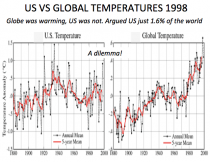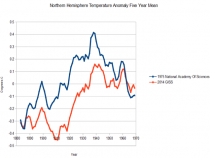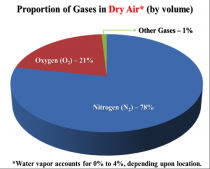Dr. Thomas P. Sheahen, Dr. James P. Wallace III & ABD. Joseph S. D’Aleo
The greenhouse effect makes this planet more hospitable. Greenhouse gas molecules in the atmosphere keep the planet warmer than it would otherwise be by re-radiating some of the energy back toward the earth - in a process called back radiation. Water vapor is by far the most important greenhouse gas. Much of the discussion of the greenhouse effect has been rooted in an incorrect picture of the atmosphere: nearly all climate models begin by assuming “dry air” as the gas. As shown in Figure 1, that assumption yields this picture of the atmosphere:
Mentioning H2O (Water vapor) in an asterisk is definitely not the right way to go about it. Dry air does not exist in nature, but must be created in the laboratory with specialized equipment. Therefore, the above picture seriously misrepresents the reality of air and the reality of the greenhouse effect. In reality, the greenhouse gases (GHGs) comprise a small finite fraction of the atmosphere, and H2O is by far the most important of them. In the pie-chart shown in Figure 2 below, we illustrate better how the greenhouse effect is “divvied up” in the real world, unlike the imaginary world of dry air.

Figure 2: Breakdown of the “natural” greenhouse effect by contributing gas. IPCC ReportAR-1. 1992. (Because halocarbons are industrial gases they are not represented here).
However, to draw even this graph, it was necessary to choose some specific amount of water vapor in a representative atmospheric model. That’s not a very reliable way to guess (given the forecast reliability of climate models), but it’s far better than guessing zero, which is the case with “dry air.” In Figure 2, 28% of the greenhouse effect is attributed to “other gases” which are almost entirely CO2. That percentage is very likely way too high. The magnitude of CO2’s influence is now being challenged worldwide See 1, 2 . However, the point we wish to make herein is about methane (CH4) and its actual greenhouse impact, not that of CO2.
In the U.S., regulation of methane emissions from numerous sources is currently being debated. Currently, this debate is not at all about the scientific basis for regulation, but rather totally about the costs involved with regulating various sources. However, contrary to the common assertions, the GHG temperature impact of methane is negligible 3 . Thus, water vapor and clouds are primarily responsible for the greenhouse gas (GHG) effect. Climate modelers have tried to model this highly complex thermodynamic process by starting with dry air and then introducing H2O as a “feedback” effect. That clearly doesn’t work as shown below.
There is a huge difference between methane as a confined gas inside laboratory equipment and methane as it is found in normal air. In the real world of real air, the very few possible absorption-lines of CH4 are utterly swamped by the prominent absorption-lines of H2O at the very same wavelengths. Any photon that might be captured by CH4 has long since been captured by H2O. Add to that the fact that there is very little energy in the CH4 region of the infrared spectrum (7.65 microns), because the radiation emanating from earth is centered around 15 microns and spread from about 9 microns to 30 microns. Also, add to that the fact that CH4 concentration is about 1.8 parts per million, while H2O is about 15,000 parts per million. As it turns out, H2O’s impacts, including its phase-change-related impacts, overwhelm everything else in the entire “greenhouse” game.
The entire furor over methane (and the “cow farts” which are good for some giggles) is simply a result of imagining an atmosphere having an idealized chemical-laboratory setting instead of thinking of the earth’s actual atmosphere, made up of real air, which contains H20 - lots of it, not to mention the enormous oceans always ready to evaporate more H2O upon warming.
The mechanism by which methane goes away is this: being far lighter than air (atomic weight 16), CH 4 drifts from the surface (where its origin is termites, wetlands, rice paddies and a little from human and animal activities, etc.) up through the troposphere into the stratosphere. There it is soon oxidized to H2O and CO2 . That happens in the daytime, aided by solar photons. (CH4 and O2 molecules don’t just automatically combine when nearby, and infrared photons are too weak to energize the reaction.) The amount of H2O in the stratosphere is about 4 or 5 ppm. Why not zero? H2O was supposed to have all frozen out and turned into clouds in the upper troposphere, was it not? It seems very likely that virtually all the H2O molecules in the stratosphere are what is produced via the oxidation of CH4. But these H2O molecules are of such low density that the H2O-to-H2O collisions (required to begin a snowflake) would occur very infrequently. People guess that the lifetime of CH4 in the atmosphere might be around 5 years. That’s a guess because it hasn’t been measured well. The many different emission sources of CH4 are ‘ubiquitous”, i.e. “all over the place” and there’s no current way to track atmospheric CH4 concentration. Moreover, there is more being originated every day. But, once again, since CH4 is lighter than air, it gradually heads for the stratosphere anyway where the above mentioned chemical reaction dispenses with it! Hence the hand-waving guess of 5 years still stands. But, nobody cares, because CH4 goes away on its own with negligible impact on the Earth’s temperature. There is no place akin to Mauna Loa where CH4 atmospheric concentration has been measured over a large fraction of the past century; thus, unlike for CO2, any claim that a century ago CH4 concentration was half its value
today is specious.
Rather the entire fear of CH4 is based entirely on the IPCC “Global Warming Potential” number being a “factor of 28 stronger” than CO2. But that concept is rooted in thinking about “dry air” in the laboratory, not about “real air” in nature.
SUMMARY
Water vapor and clouds totally dominate the greenhouse gas impact on the Earth’s temperature. Methane emissions have negligible impact and there is no need whatsoever for their regulation. In fact, the cost/benefit ratio associated with any attempt at regulation to reduce methane emissions would be infinite, since the “global cooling benefit” would be zero - not to mention the costs being huge!
1 See Data Research Report
2 See: EF DATA Comment on Christy et al Paper Press Release V5
3 See: GREENHOUSE GASES - A MORE REALISTIC VIEW at this LINK , pg. 7-9 & Methane and Climate, By W. A. van Wijngaarden and W. Happer, CO2 Coalition, 2020 (Link)
I have been involved in my entire career in attribution analysis in weather and climate. It started in grad school when I did my thesis on the conditions that lead to explosive development in east coast winter storms (now called bomb cyclones). In the early 1970s, my doctoral work was on atmospheric chemistry. At the time the concern was on the effects of particulates that man produced and the threat of global cooling as well as greenhouse gases like water vapor and to a smaller degree trace gases like CO2. In most presentations over the years I have pointed out that CO2 has been much higher in the past than today, that it is at coming off plant growth limiting low levels as Dr Patrick Moore and Princeton Physicist Will Happer have discussed and presented. We breathe out 100 times the CO2 than we breathe in. We pump CO2 into greenhouses at 3 to 4 times ambient levels.

After one such presentation, the modeller who presented, responded to me that a drop or two of arsenic in a drink could kill someone. I told him put the two drops in a lake and not even a single minnow dies. I reminded him:
The solution to pollution is dilution
At the same time as I was doing grad work, i worked 7-day a week as weather producer for the CBS broadcasts in NYC, I had to deal with the urban versus rural, sea coast versus hilly interior temperature variances in one of the biggest and important and diverse viewing regions.
In the mid-1970s, as a professor at a budding new program at LSC in VT. My courses were on weather, climatology, microclimatology, analysis and forecasting. While there, my students and I were fortunate to meet and learn from the guest giants in the field including Jerome Namias on the roles ocean warm and cold pools have on seasonal weather and how these change longer term. We learned also from MIT’s Hurd Willett also some ways solar cycles have an effect on climate on the short term, decadal and longer periods. And from the great David Ludlum on extremes of the past.
In the 1980s as the first Director of Meteorology at The Weather Channel, I brought in more experts for the staff and we together pioneered in medium range forecasting, in seasonal forecasting and educational features on what conditions affect hurricanes, tornadoes, floods and droughts and snow. We did stories on El Nino before it became a household name.
Late in the 1980s, research showed how El Ninos and La Ninas had global impacts and that the Pacific Ocean went through decadal changes that influenced global temperatures and extremes. In the 1990s, I found the Pacific Decadal phases influenced the frequency of El Ninos and the resulting conditions in North America. Research in this time period also showed solar effects were modulated by the high level tropical winds which we added to our toolbox.
TEMPERATURE DATA
In the late 1980s, NCDC and Tom Karl issued the first version of US historical data back to 1895. It was adjusted for urbanization. We correlated these features with this high quality US data and found the oceans and sun could explain all the changes we saw in our climate back to the late 1800s (link). I published peer-reviewed papers and made frequent presentations on this finding and showed the ability to use them to predict upcoming seasons, developing a statistical model to predict global seasonal changes. I found some of these same factors play a key role on the risk of extremes, which we use to advise regions at risk.
This U.S. data set was widely thought to be the best data in the world - for stability of the stations and coverage. But it showed no warming. NASA who relied on NOAA for US data and NOAA both had to explain why the temperatures in the record for the US were cyclical with no upward bias in the entire record like the first operational global NOAA data set global land data released in 1992. They had to say the U.S. only covered 1.6% of the land areas and was not representative of the true trend.
This ‘bothersome 1940 warm blip’ like the Medieval Warm Period were the true “Inconvenient Truths” of the past 20 years.

While we were getting smarter about the real drivers, politics was driving climate science in another direction. The scientific method was abandoned and unprecedented funding incented scientists, laboratories, universities and government agencies to show that CO2 was the main driver for the warming cycle and all extremes of weather. The sinister goal was to control our energy sources, manufacturing and ultimately with all their progressive agenda programs all aspects of our life. They believe as people felt the pain they would turn to government to save them.
The most terrifying words in the English language are: I’m from the government and I’m here to help. Ronald Reagan
The now debunked hockey stick and a new US data version w/o UHI adjustments took care of the inconvenient data, They played whack a mole with the data to eliminate the earlier warm periods so they could make a case this was unique and must be our fault.


Initially, this global data had a cyclical pattern similar to previously reported Northern Hemisphere data (high in the 1930s and 40s, low in the 70s). Then, as time progressed, the previous officially reported GAST data history was modified, removing the cycle and creating a more and more strongly upward sloping linear trend in each freshly reported historical data set. Peer reviewed, published and readily reproducible research has shown that: "The conclusive findings were that the three GAST data sets are not a valid representation of reality."
In fact, the magnitude of their historical data adjustments, which removed their cyclical temperature patterns are completely inconsistent with published and credible U.S. and other temperature data. Thus, despite current assertions of record-setting warming, it is impossible to conclude from the NOAA and NASA data sets that recent years have been the warmest ever.
Models had become the principal tool to create data to fill in the large gaps that existed in the historical data as well as adjust the data. By mixing data with models you can more easily manipulate trends to better agree with theories. Professional societies and their journals became an important part of the climate cabal, controlling what gets published. With help from the compliant media every event is proclaimed to be our fault and made a reason to abandon low cost and reliable energy.
The journals claim they now have a strong case for attribution for extreme weather given CO2 changes to temperature. This is patently false.
They claim record highs are increasing but in actual fact, heat records have decline since the 1930s and for US long-term stations. Record high and low data has not been modified because they are in widespread use unlike the longer-term data. The top ten years for 90F temperatures were all before 1956. Global temperatures for the continents all peaked long ago, but a few new records have been found the last two years as they have been aggressively looking to make that other inconvenient fact go away. Hurricane and major hurricane landfall this past decade were both the lowest since 1850. This last decade had the fewest major tornadoes. Droughts and floods show not clear trends and earlier in 2019, we had the smallest areal extent of drought in the U.S. in the record, Snow has increased in the U.S. and globally with fall snowcover at record levels and winter rising. Snow in spring and summer is down but as NOAA advised in 2000 they made a change to automated sensing which affects areal extent in the warm season and data pre and post 2000 comparisons were not advised. Arctic ice decline relates to cycles of warm and cold in both the Atlantic and Pacific. Current levels are comparable to the 1920s to 1950s. This cycle is seen in Greenland as well. Antarctic ice set a modern record high a few years ago. Sea level rise has slowed globally. An adjustment was made up to satellite measurements of sea level when they could not detect sea level rises. See much more detail on the big WEATHER IS MORE EXTREME lie here.
Their control over the data and the models and of the publications turned climate change into a non-falsifiable hypothesis. Anyone who disagrees is declared an enemy of the people.
THE REAL DANGER
Current climate policies- based on these unreliable temperature records - threaten our economic and national security interests. As the proposed climate policies grow more extreme, the consequences of allowing this record to remain unchallenged gravely threatens an onslaught of litigation based on the greenhouse gas endangerment finding. Importantly, this litigation imposes significant impediments to the mineral land leasing and pipeline infrastructure build out necessary to maintain and enhance energy independence and economic prosperity.
Furthermore, the US financial sector has already dramatically curtailed its support of conventional energy source development in large part due to the continued calls for regulatory destruction of the fossil fuel industry based substantially on NOAA and NASA’s now invalidated global surface temperature records. This situation is putting our Nation’s energy security at grave risk - which means our economic and national security are also in great peril.
Some Published reviews and press releases our team have produced.
URL FOR 2011 KISS Paper
URL for 2017 Research Report and Press Release.
URL for GAST RR Press Release: June 2017
URL for 2017 GAST Report GAST RR: June 2017
URL for the EF DATA Comment on Christy Paper Third RR:
URL for the EF DATA Comment on Christy et al Paper Final 042818V4
URL for Alarmist Claim Rebuttals AC Rebuttals:
See the Heartland’s Climate at a Glance here.
Cartoon Dilbert: On Sun, Mar 10, 2019
URL FOR THE 031519 NSPS COMMENT FILING - FINAL
All our efforts are volunteer (pro-bono). Help us with a donation if you can (left column).



